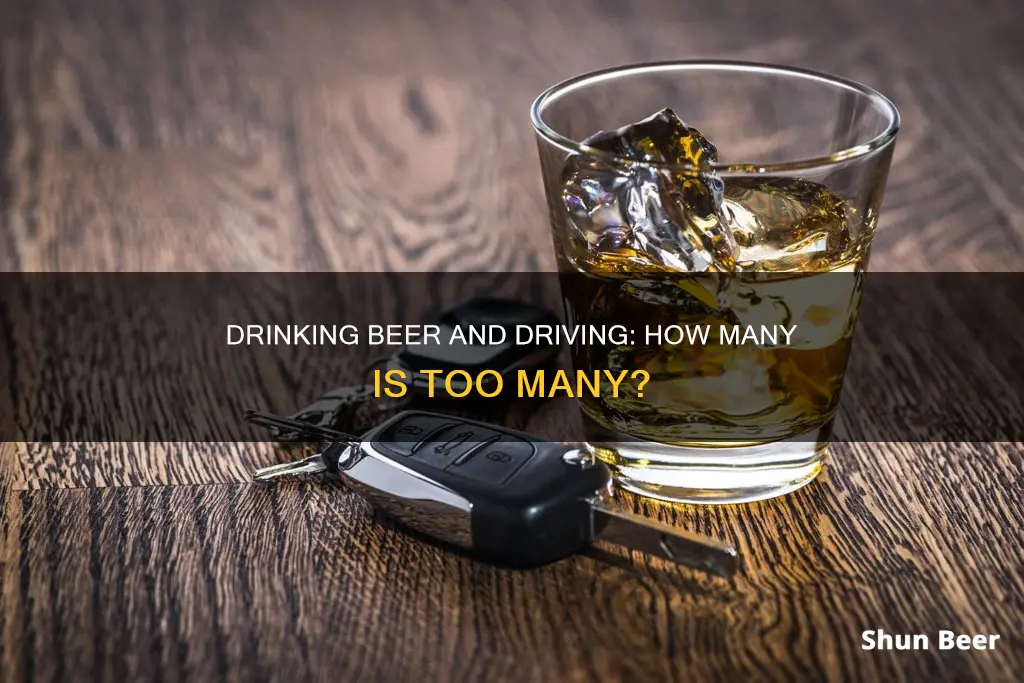
Drinking and driving is a dangerous combination. Alcohol affects your driving ability by impairing your judgment, slowing your reaction time, and making it difficult to focus on the road. While it's difficult to determine exactly how many pints of beer a person can drink and still be safe to drive, as it varies from person to person, the general rule is that if you're drinking, don't drive. The legal alcohol limit for driving in the UK is 80 milligrams of alcohol per 100 millilitres of blood or 35 micrograms of alcohol per 100 millilitres of breath. In the US, a Blood Alcohol Concentration (BAC) of 0.08 grams of alcohol per deciliter or higher is above the legal limit. To stay safe, it's best to avoid driving after consuming any amount of alcohol and to make alternative travel arrangements.
| Characteristics | Values |
|---|---|
| Number of pints men can drink and drive in England, Wales and Northern Ireland | 2 |
| Number of pints women can drink and drive in England, Wales and Northern Ireland | 1 |
| Number of pints men can drink and drive in Scotland | 1 |
| Number of pints women can drink and drive in Scotland | 0.75 |
| Number of hours it takes for a pint of beer to leave the body | 2-3 |
| Number of hours it takes for a unit of alcohol to leave the body | 1 |
| Number of micrograms of alcohol per 100ml of breath in England, Wales and Northern Ireland | 35 |
| Number of micrograms of alcohol per 100ml of breath in Scotland | 22 |
| Number of milligrams of alcohol per 100ml of blood in England, Wales and Northern Ireland | 80 |
| Number of milligrams of alcohol per 100ml of blood in Scotland | 50 |
| Number of milligrams of alcohol per 100ml of urine in England, Wales and Northern Ireland | 107 |
| Number of milligrams of alcohol per 100ml of urine in Scotland | 67 |
What You'll Learn

Factors affecting alcohol tolerance
The number of pints of beer one can drink and still be safe to drive depends on various factors. The UK limit is 80 milligrams of alcohol per 100 millilitres of blood or 35 micrograms of alcohol per 100 millilitres of breath. In Scotland, the limits are lower: 50 milligrams of alcohol per 100 millilitres of blood or 22 micrograms of alcohol per 100 millilitres of breath.
A pint of beer contains approximately 2.3 units of alcohol. This amount can affect individuals differently, depending on factors such as weight, gender, age, genetics, medications, and health conditions.
Age
Younger individuals tend to have lower alcohol tolerance than older individuals.
Weight
People with lower body weight tend to have lower alcohol tolerance.
Gender
Women generally have lower alcohol tolerance than men due to differences in body composition and metabolism. Women tend to have a higher percentage of body fat, which reduces the percentage of lean body mass that can distribute alcohol concentration.
Genetics and Ethnicity
Genetics and ethnicity can influence alcohol tolerance. For example, individuals of Asian or Native American descent typically show reduced levels of alcohol dehydrogenase, an enzyme that metabolises alcohol. As a result, alcohol remains in their bloodstream longer, leading to higher intoxication levels.
Medications
Mixing alcohol with certain medications can be dangerous and affect intoxication levels. Over-the-counter medications such as aspirin, ibuprofen, and acetaminophen, as well as prescription drugs, can impact how the body processes alcohol.
Health Conditions
Health conditions and emotional states can also play a role in alcohol tolerance. For instance, individuals who are sick, tired, or experiencing strong emotions like anger, fear, or loneliness may become impaired more quickly.
Alcohol-Free Beer: A Safe Choice for Alcoholics?
You may want to see also

How many units of alcohol are in a pint of beer?
The number of units of alcohol in a pint of beer depends on the alcoholic content and the total volume of liquid. A pint of beer is typically around 568ml. The alcoholic content is measured by alcohol by volume (ABV).
A pint of standard-strength lager or ale with a 4.5% ABV contains 2.5 units of alcohol. However, this amount varies depending on the strength of the beer. For instance, a pint of strong lager with a 5.2% ABV contains 2.95 units of alcohol, whereas a pint of lower-strength lager with a 3.6% ABV contains just over 2 units.
To calculate the number of units of alcohol in a drink, you can use the following formula:
> strength (ABV) x volume (ml) ÷ 1,000 = units
For example, to calculate the number of units in a pint (568ml) of lager with an ABV of 4%, you would do the following calculation:
> 4% x 568ml ÷ 1,000 = 2.3 units
It's important to note that the number of units of alcohol in a drink can vary depending on various factors, such as weight, gender, metabolism, and whether you've eaten or taken any medications. The effects of alcohol can also differ from person to person. Therefore, it is always recommended to avoid driving after consuming any amount of alcohol.
Beer Drinking: Harmful Health Effects You Need to Know
You may want to see also

How long does alcohol stay in your system?
It's important to remember that drinking any amount of alcohol can affect individuals differently, and there are many factors that influence how long alcohol stays in your system. These factors include weight, age, gender, metabolism, and the amount and strength of the alcohol consumed.
On average, the liver metabolises alcohol at a rate of one unit per hour. In the UK, one unit of alcohol is 8 grams of pure ethanol, or 10ml of ethanol. This means that a drink containing 40% ABV vodka (40% pure ethanol by volume) would contain 4 units of alcohol in a 100ml measure.
Using this information, we can estimate how long it takes for different drinks to leave your system. For example, one pint of average-strength beer or lager (2.5 units) would take approximately 2.5 hours to clear from your system. A single measure of whisky (1 unit) would take around 1.5 hours, while a double measure (2 units) would take 3.5 hours.
It's important to note that these are just estimates, and the actual time may vary depending on individual factors. Additionally, alcohol can be detected on the breath for up to 24 hours, in urine for 24-96 hours, and in blood for up to six weeks.
To ensure safety, it is always best to wait until you are sure that all alcohol has left your system before driving. This means not drinking at all if you plan to drive, or making alternative travel arrangements if you intend to drink. Remember, even small amounts of alcohol can impair your judgment and coordination, putting yourself and others at risk.
Enjoying Beer at River Riders: What You Need to Know
You may want to see also

What happens if you're found drinking and driving?
Drinking and driving is a criminal offence in the UK. If you are found to be drinking and driving, the police may request that you take a breathalyser test. Refusing to comply can lead to arrest, while failing the test means you will have to take another test at a police station. If you are found to have too much alcohol in your system, you will face charges.
The charges for drinking and driving vary but may include an unlimited fine or imprisonment, depending on whether you committed any driving offences while under the influence of alcohol. You could also face a driving ban for a varying amount of time. If you are in charge of a vehicle while above the legal limit or unfit through drink, you could face up to three months in prison and a fine of up to £2,500. If you drive or attempt to drive while above the limit, you could face up to six months in prison and a driving ban for at least a year (or three years if convicted twice in 10 years). Causing death by careless driving while under the influence of alcohol can result in up to 14 years in prison, a driving ban for at least two years, and an extended driving test before your licence is returned.
In addition to legal penalties, drinking and driving can have other negative consequences. Your car insurance costs will increase significantly, and you may lose your job, especially if you drive for work as your employer will see the conviction on your licence. A criminal record may also make it difficult to find employment in the future or to travel to certain countries, such as the USA.
Beer and Rifampin: Safe or Not?
You may want to see also

Tips for staying within your alcohol limit
The number of pints of beer one can drink and still drive varies depending on several factors, including assigned sex at birth, medications taken, how much one has eaten, and the strength and type of alcohol consumed. According to one source, men can consume two pints of medium-strength lager or cider (4.5%) and remain under the drink-drive limit in England, Wales, and Northern Ireland. On the other hand, women can have one pint and stay within the limit. However, it is important to note that these are general guidelines, and the actual limit can vary from person to person.
- Eat before drinking: Eating before consuming alcohol can slow down the absorption of alcohol into the bloodstream. It is recommended to eat before and while drinking to prevent the alcohol from entering your bloodstream too quickly.
- Drink water or non-alcoholic beverages: Alternating alcoholic drinks with water or other non-alcoholic beverages can help you stay hydrated and slow down your alcohol consumption.
- Avoid drinks with high alcohol content: Opt for lower-strength drinks or low-alcohol options. Check the bottle or can for the alcohol percentage (ABV %) to make an informed choice.
- Plan alternative transportation: Always plan ahead and arrange for alternative transportation when you know you will be drinking. This can include designating a sober driver, using public transportation, or utilizing taxi or ridesharing services.
- Set a drink limit: Before you start drinking, decide on a fixed number of drinks you will have and stick to it. You can also only carry a limited amount of cash to spend on alcohol.
- Recognize the signs of alcohol impairment: Be aware of the signs of alcohol impairment, such as impaired balance and coordination, impaired judgment, and drowsiness. If you start exhibiting any of these signs, stop drinking and refrain from driving.
- Have drink-free days: Incorporate several drink-free days into your weekly routine. This will help you cut back on your overall alcohol consumption and give your body a break.
Beer Overdose: Stomach Problems and Solutions
You may want to see also
Frequently asked questions
There is no one-size-fits-all answer to this question as it depends on various factors such as weight, height, body fat, metabolism, medication, food consumption, and the type of beer consumed. However, as a general guideline, men can have 2 pints of medium-strength lager or cider (4.5%) and women can have 1 pint and remain under the drink-drive limit in England, Wales, and Northern Ireland.
The time required to wait before driving after drinking beer varies depending on individual factors such as weight, metabolism, and assigned sex at birth. On average, it takes the liver around an hour to process 1 unit of alcohol, but alcohol can remain in the blood for up to 6 hours and on the breath for up to 24 hours. It is recommended to err on the side of caution and refrain from driving if there is any uncertainty about sobriety.
Drink-driving is a severe offence that can result in legal and financial repercussions. Penalties include a minimum 12-month driving ban, up to a £2,500 fine, and up to 6 months in prison. A drink-driving conviction can also lead to increased insurance prices or refusal of coverage by insurers. It is crucial to make alternative travel arrangements if you plan on consuming alcohol, such as public transport, taxis, or designating a sober driver.







